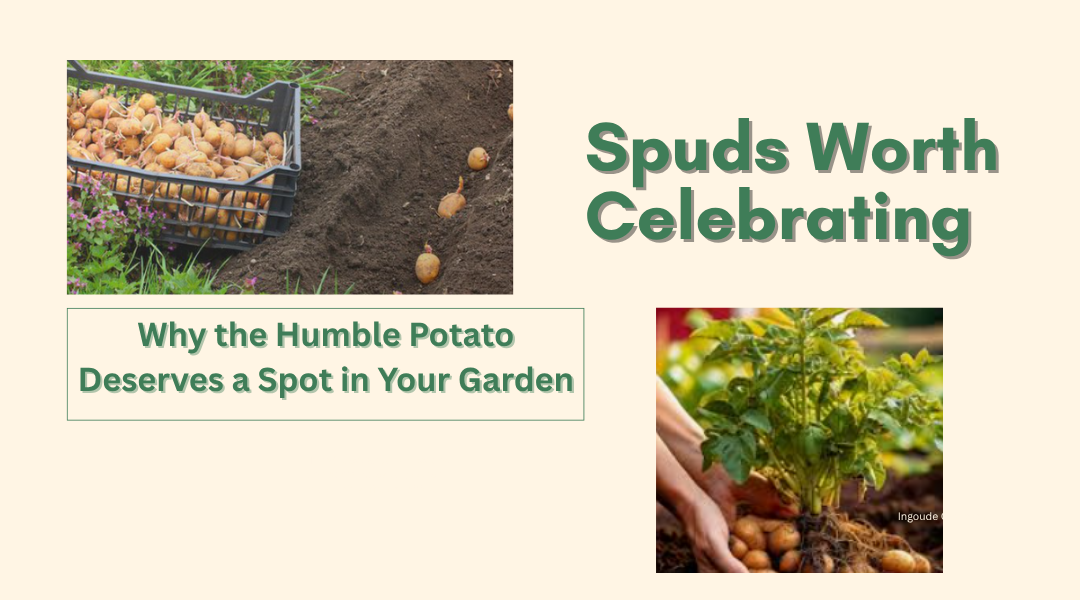When you think of “superfoods,” potatoes probably don’t come to mind. They’re not trendy like kale, exotic like açai, or Instagrammable like avocado toast. But that’s exactly why they’re so brilliant. While other crops come and go as fads, the potato has quietly fed empires, survived wars, and kept families fed through hard times. And if you’re not growing them yet? You’re missing out on one of gardening’s easiest wins.
A Brief (and Surprising) Potato History
Picture this: centuries before Europeans even knew potatoes existed, the Inca were perfecting ways to grow them in the thin air of the Andes. They freeze-dried them into chuño (a kind of ancient astronaut food that could last decades), worshipped them as divine gifts, and even used specific varieties to measure time (some spuds took exactly one lunar cycle to cook).
Then came the Spanish, who initially dismissed potatoes as “food for the conquered.” But after starving sailors realized potatoes prevented scurvy better than limes, the tuber got a one-way ticket to Europe—where it was met with suspicion. The English thought they caused leprosy. The French aristocracy refused to eat anything that grew underground like a “peasant’s root.” It took a PR stunt involving Marie Antoinette wearing potato blossoms in her hair (and a fake “guarded field” scheme by Parmentier) to finally make them fashionable.
Fast-forward to today: potatoes are the world’s fourth-largest food crop, feeding everyone from astronauts (NASA tested them as a Mars crop) to hipster chefs turning them into gourmet gnocchi.
8 Reasons to Grow Your Own
- They’re the Ultimate Beginner Plant
Unlike fussy tomatoes or mold-prone zucchini, potatoes are gloriously low-drama. Forget pH-balanced soil or perfect sunlight—if you can dig a hole, you can grow potatoes. I’ve seen them thrive in everything from trash cans to abandoned tires. - More Nutritious Than You Think
That “carbs are bad” myth? Ignore it. A single russet potato has:- More potassium than a banana
- Half your daily vitamin C (yes, really)
- Resistant starch, which acts like fiber for your gut
Plus, they’re naturally gluten-free and easier to digest than beans or grains.
- The Original Survival Food
Ask any Irish grandparent: when the wheat fails, potatoes save lives. During WWII, British families were encouraged to grow them in “Victory Gardens” because they produced more calories per square foot than any other crop. Store them in a cool, dark place, and they’ll last months. - Grow Them Anywhere
No yard? No problem. I’ve grown potatoes in:- A stack of old pallets lined with burlap
- A broken washing machine tub (true story)
- A fabric grocery bag filled with compost
They’re the ultimate urban garden hack.
- Zero-Waste Cooking
Most veggies leave you with scraps. Potatoes give you options:- Peels? Fry into crispy chips.
- Eyes sprouting? Cut and plant them.
- Too many? Make vodka (okay, that’s advanced).
- Pest-Proof(ish)
Deer won’t touch them. Aphids ignore them. Your biggest threat? Colorado potato beetles—but a quick daily flick into soapy water solves that. - Seed Savings
Store a few spuds from your harvest, and you’ve got next year’s crop—no seed packets needed. Heirloom varieties like ‘Russian Banana’ fingerlings have been passed down for generations this way. - Climate Adaptability
From Alaskan frosts to Texas heat, there’s a potato for it. ‘Adirondack Blue’ thrives in cold, while ‘Elba’ laughs at drought.
A Potato for Every Plot
- For Small Spaces: ‘Yukon Gold’ (buttery flavor, compact growth)
- For Survivalists: ‘Kennebec’ (stores for 6+ months)
- For Fun: ‘All Blue’ (vibrant purple flesh that stuns in salads)
Final Thought: The Underdog Crop
In a world obsessed with exotic superfoods, the potato is the quiet hero—unpretentious, reliable, and packed with more history (and nutrition) than most realize. Whether you’re prepping for hard times or just want a garden crop that actually survives your “care,” grab some seed potatoes and get planting. As the Irish say: “Spare the rod, plant the spud.” (Okay, they don’t say that. But they should.)
Pro Tip: For an early crop, plant ‘Red Pontiac’—they’ll give you new potatoes in just 60 days. Boil them with mint and butter, and you’ll wonder why you ever bothered with store-bought.
